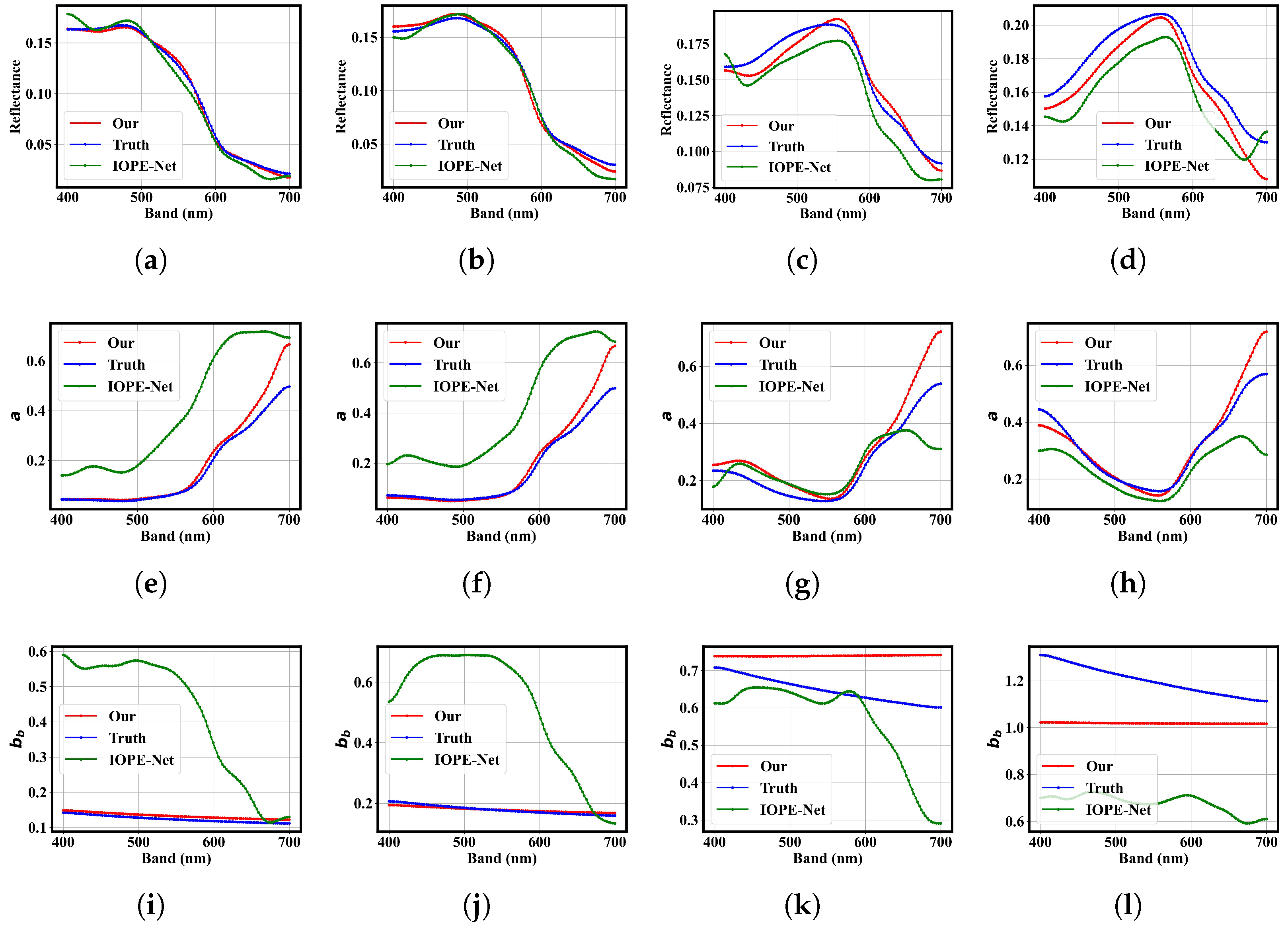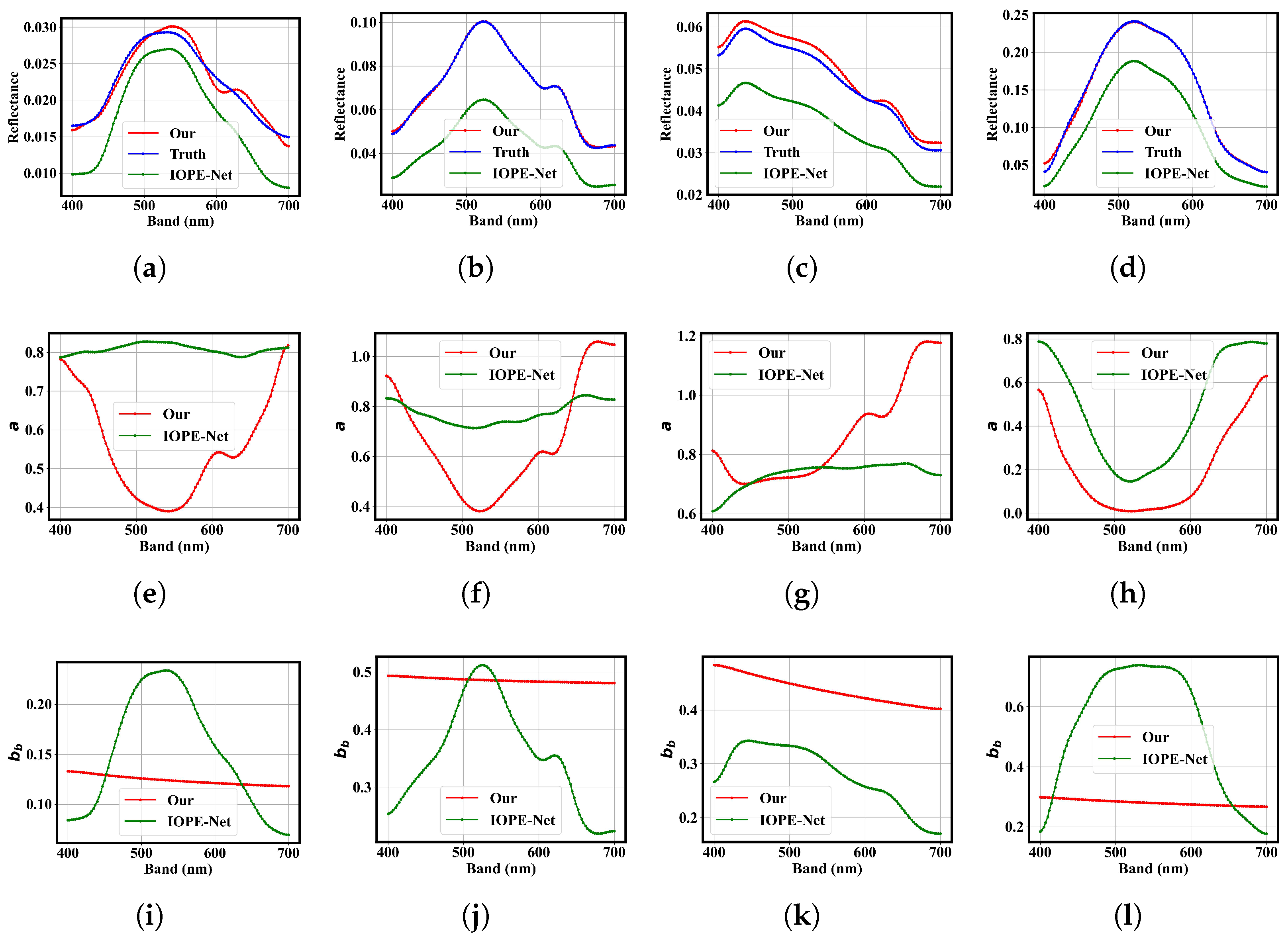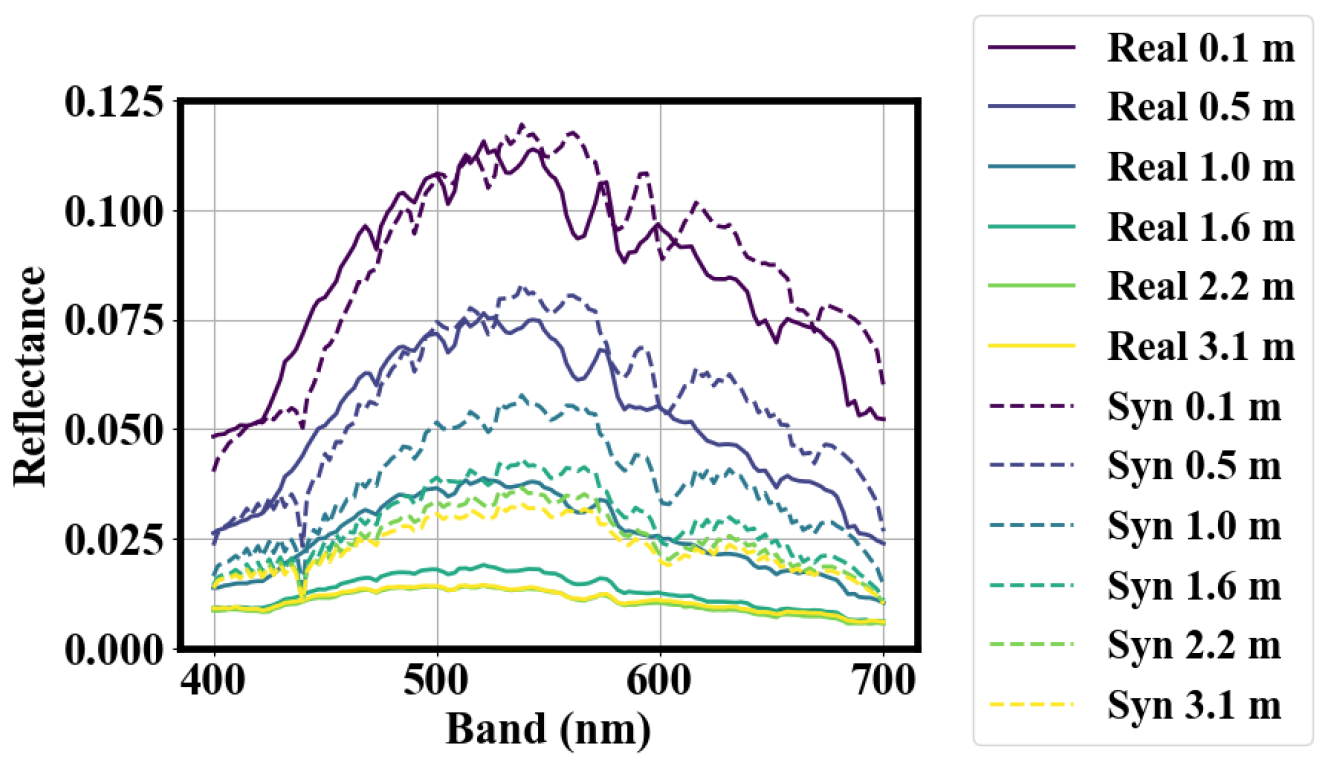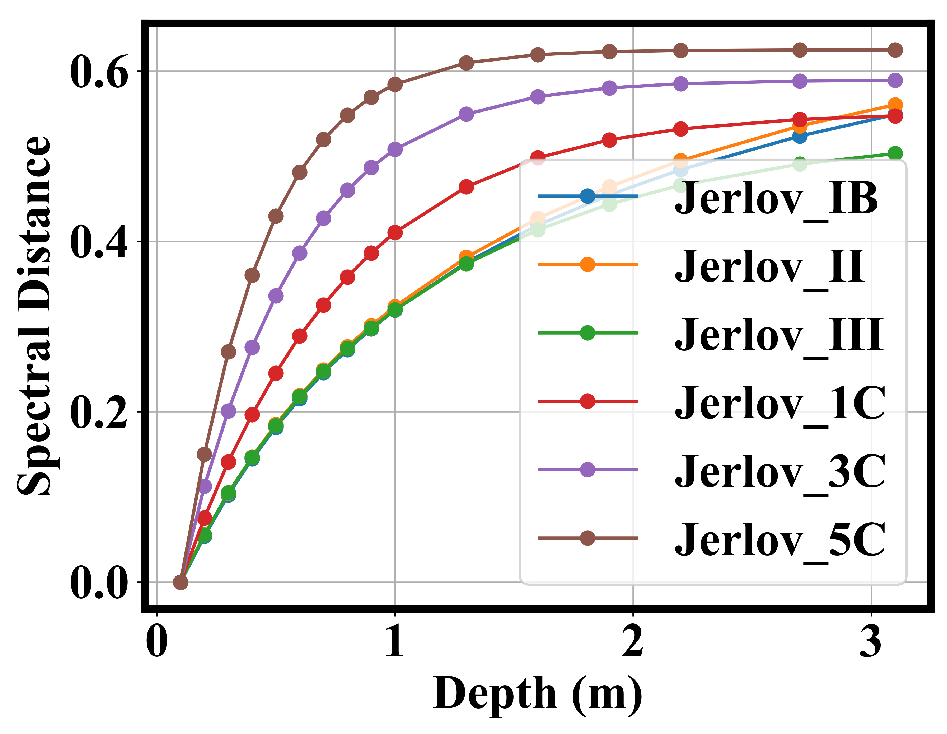1. Introduction
Developing hyperspectral underwater target detection technology is critical in key fields such as marine resource exploration, environmental monitoring, and underwater operations [
1,
2,
3,
4,
5,
6]. Advancements in this technology enhance the theoretical framework of vision-based target detection and provide strong technical support for the accurate identification and efficient management of underwater environments. With its powerful learning and generalization capabilities in image recognition and processing, deep learning [
7,
8,
9,
10] has become a driving force in advancing hyperspectral underwater target detection [
11,
12,
13]. However, the performance of deep learning models heavily relies on large-scale, high-quality training datasets [
14]. In the domain of airborne passive remote sensing in shallow water environments, obtaining high-quality hyperspectral image data is highly challenging due to the complexity and variability of the underwater environment. Therefore, it is necessary to develop a framework to estimate water IOPs from hyperspectral imagery.
The key to constructing a synthetic dataset for hyperspectral underwater targets is obtaining essential water inherent optical properties (IOPs). Gillis et al. [
15] used a semi-analytical model in combination with a look-up table strategy to derive the intrinsic optical properties. It estimated the water remote sensing reflectance by pre-computing many water spectra with known IOPs and retrieving the best-matching IOPs. Based on this, the Ecolight model is used to generate synthetic underwater target spectra, which are then embedded in the background of the dataset after adding noise. However, this method has several limitations, such as the lack of intelligence in estimating water column optical properties, computational inefficiency due to reliance on large spectral libraries, and limited applicability to complex and dynamic underwater environments.
There is a critical need for more efficient and intelligent methods for estimating the water IOPs. For this, Qi et al. proposed the IOPE-Net, a deep learning-based network designed for the intelligent estimation of the water IOPs [
16]. IOPE-Net relies on an optical deep water bathymetric model. It employs a hybrid sequence structure to extract high-dimensional nonlinear features from water column spectra for the unsupervised inversion of absorption and backscattering coefficients. However, in the simplified bathymetric model for optically deep water, due to the inherently non-unique relationship between absorption and backscattering coefficients, the inversion results produced by this method may lack physical interpretability and may not yield unique solutions. In reality, the absorption and backscattering properties of the water column are closely tied to factors such as the concentrations of chlorophyll, colored dissolved organic matter (CDOM), and detrital material. Considering this issue, we combine the IOPs estimation network with the IOPs physical model, which provides a detailed description of the water column’s optical properties.
IOPs are key parameters that describe light’s absorption and backscattering behaviors as it propagates through water. Absorption properties precisely quantify the extent to which various substances in the water scenario absorb light. Major absorbing components in the water column include pure seawater, chlorophyll from phytoplankton, CDOM, and non-algal particles (NAP) [
17,
18,
19,
20]. For the absorption properties of pure seawater, Pope et al. used the integral cavity technique to measure the continuous absorption spectral profile of pure seawater over the wavelength range of 380–700 nm [
21]. Lee et al. proposed a model to resolve the spectral properties of seawater across the visible to infrared ranges, considering factors such as bottom reflectivity, chlorophyll or CDOM absorption, and backscattering from the water column [
22]. Additionally, Howard et al. demonstrated that the absorption coefficient of chlorophyll at 440 nm is closely correlated with chlorophyll concentration [
23]. Regarding CDOM absorption characteristics, Kirk et al. have extensively studied the absorption coefficients of CDOM in offshore and inland water since 1994 [
24]. Bricaud et al. expanded this research by focusing on CDOM absorption coefficients in marine water [
25]. Furthermore, Babin et al. examined how four phytoplankton species, plant debris formed during phytoplankton cultivation, and natural combinations of mineral particles from various samples affect water absorption characteristics [
26].
Among the water IOPs, the backscattering coefficient describes the extent to which light is deflected as it propagates through water. It is influenced by three primary components: pure seawater, detrital particles, and chlorophyll (an important component of phytoplankton) [
27]. Morel [
28] provided a continuous spectral profile on the backscattering of pure seawater in the wavelength range of 380–700 nm. Although these data are based on empirical formulas, their reliability and applicability have been extensively verified, making them widely used in seawater optics research. Lee et al. further investigated the relationship between water-leaving radiation and the water IOPs [
29], focusing on the backscattering characteristics of detrital materials. These materials, composed of organic and inorganic fine particles, are major contributors to the backscattering properties of the water column. Furthermore, Howard et al. demonstrated that the backscattering coefficient of chlorophyll in phytoplankton at 440 nm is strongly correlated with its concentration, highlighting chlorophyll’s dual role in both absorption and backscattering properties of water [
23].
Despite the remarkable progress achieved by IOPE-Net [
16] in retrieving water IOPs through an unsupervised autoencoder framework, several limitations still persist. First, the model is primarily based on a simplified bathymetric assumption for optical deep water, which overlooks the complexity of real aquatic environments. Under this assumption, the relationship between the IOP coefficients and the deep-water reflectance often leads to non-unique or physically inconsistent inversion results. Consequently, the existing IOPE-Net framework may fail to obtain physically meaningful and uniquely determined IOP estimations. These limitations hinder the accurate characterization of the optical properties of natural waters.
In addition to IOPE-Net, traditional empirical and semi-analytical approaches for water IOPs retrieval typically depend on prior knowledge of water type or fixed analytical models, limiting their adaptability and robustness in diverse optical conditions. While recent deep learning-based methods have demonstrated strong nonlinear fitting capabilities, they often suffer from a lack of physical interpretability, which can lead to unrealistic or unstable parameter estimations. Considering these limitations, IOPE-Net serves as a representative baseline of unsupervised IOPs estimation, whereas our proposed IOPE-IPD network aims to further integrate physical constraints into the data-driven framework to achieve both accuracy and interpretability in IOPs estimation.
This paper proposes a novel framework that integrates physical modeling and deep learning to estimate water inherent optical properties with high accuracy and interpretability. Specifically, we construct an IOPs physical model that quantifies the influence of water constituents—chlorophyll, colored dissolved organic matter (CDOM), and detrital material—on absorption and backscattering coefficients. Building on this model, we develop the IOPE-IPD network, which consists of an encoder and dual decoders for estimating key water quality parameters from hyperspectral inputs. The estimated parameters are used to compute IOPs and retrieve the input water spectrum via a bathymetric model, guided by a consistency loss to ensure spectral fidelity. We validate our approach across diverse aquatic scenarios, including real-world and Jerlov-simulated water bodies, demonstrating the robustness and generalization capability of our proposed method. The key innovations of this paper include the following:
A novel IOPs estimation network integrating physical model and deep learning is proposed. It enables the accurate estimation of water column absorption and backscattering coefficients that are physically meaningful and interpretable.
The IOPs physical model is proposed, which represents the absorption and backscattering coefficients of the water column using four key parameters, facilitating the mathematical characterization of water properties.
To ensure the generalizability of IOPE-IPD, both real-world and Jerlov-simulated aquatic environments are used. Comprehensive experimental results demonstrate the robustness and superior performance of the proposed method compared with the existing method.
The remaining sections of the paper are organized as follows. In
Section 2, a brief overview of related work is provided.
Section 3 presents the detailed methodology proposed in this paper.
Section 4 provides the experimental performance analysis.
Section 5 discuss related analysis. Finally, a conclusion of the paper is provided in
Section 6.
6. Conclusions
In this paper, we propose IOPE-IPD, a novel network for estimating water inherent optical properties from hyperspectral data by combining physical modeling with deep learning. By introducing an IOPs physical model describing how chlorophyll concentrations, CDOM, NAP, and DM influence the absorption and backscattering coefficients, we enabled physically interpretable and accurate estimation of key parameters. The dual-decoder architecture of IOPE-IPD, together with a consistency-constrained retrieve process using a bathymetric model, ensures both precision and effectiveness. Extensive experiments across actual and simulated aquatic environments demonstrate the robustness, generalizability, and superior performance of our approach.
In future work, we aim to extend our method to estimate water inherent optical properties directly from satellite remote sensing data, enabling large-scale and efficient monitoring of aquatic environments. We also plan to further investigate the model’s performance in highly turbid and optically complex waters to enhance its robustness and applicability. Furthermore, we fully acknowledge the importance of extending this framework to stratified water conditions. Specifically, we plan to (1) incorporate depth-dependent IOP parameterization into the network to enable layer-wise estimation of absorption and backscattering coefficients, and (2) analyze the influence of the vertical distribution of chlorophyll and other optically active substances on spectral reflectance through simulated multi-layer radiative transfer modeling. These enhancements will further improve the physical interpretability and generalization ability of the proposed model under more complex aquatic environments.

















